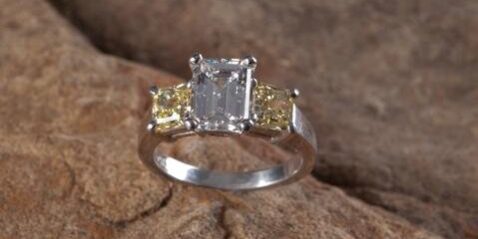Clarity is one of the “4 Cs” of diamond evaluation, among carat, cut, and color. Diamonds are graded for the absence of inclusions– which are flaws– that make the stone less than perfectly clear.
This F color VS1 three stone ring really catches the light!
Clarity can be one of the trickiest of the 4Cs for people to understand, especially when choosing a diamond for an engagement ring or other pieces of fine jewelry. The complexity comes from the wide variety of the types of inclusions and the difference of visual appearance of each, and also from the grading terminology.

The GIA clarity scale ranges from flawless to included. Source- GIA.
The diamond clarity scale used by GIA and other reputable diamond grading labs represents how clear a diamond is, which in conjunction with other factors like cut and polish, translates to how well it sparkles. In general, for well-cut and well-polished stones, the higher the clarity, the more it sparkles.

This Internally Flawless Old Mine Cut diamond engagement ring by Secrète Fine Jewelry was so sparkly we were mesmerized.
The trouble is that not all inclusions have the same impact on the appearance of a diamond. For example, a black carbon spot really messes up the look of a diamond, while a small milky cloud hidden under lots of facets doesn’t distract from the look of the stone much.

This VS1 oval diamond solitaire engagement ring by Secrète Fine Jewelry shines beautifully. Even better– this is a certified Canadian ethically-sourced diamond!
Here is an side-by-side comparison of the difference in the appearance of two diamonds that are both SI1. Both are G color, SI1, 1ct, very good cut, polish, and symmetry, no fluorescence (basically identical on paper). Notice how one looks worse than the other. The slight inclusions on the first stone are black spots, where the slight inclusions on the second stone are white clouds. Look at the diagrams issued by the labs for these two stones– it’s hard to know that one will look better in real life than the other.

This diamond is a 1.00ct G color SI1 Very Good cut, polish, and symmetry, GIA certified. It has so many black spots Cruella DeVille tried to murder it to make a coat.

This is also a 1.00ct G color SI1 Very Good cut, polish, and symmetry GIA diamond. It has some white clouds in the middle, but they’re much less noticeable than the black spots on the diamond above.
This is where it gets tricky– you might be thinking if these two diamonds have identical reports, how can I know what the clarity of my diamond will look like based on the grade?

This is the lab diagram for the black-spot SI1 diamond.

This is the diagram for the cleaner looking SI1 diamond. To a lay-person, you may think the red dots in the middle of the bottom diagram would correspond to a worse look, but they actually connote cloudiness, not spottiness.
There are a couple things to consider. First, all diamonds graded VS2 or better will be “eye-clean” meaning there are no visible inclusions to the naked eye. They may not all look the same, but you can be sure that at VS2 or higher, you won’t have any black spots. Some SI diamonds are eye-clean, but not all. Second, an experienced jeweler will be able to find you a beautiful, eye-clean diamond based on knowledge and expertise better than you can do yourself looking at stock photos and hard-to-interpret diagrams on DIY diamond-buying websites.

This classic engagement ring from our catalog features a flawless emerald-cut white diamond and two flawless princess-cut canary diamonds.
Second, diamond clarity can also be more important with some cuts than others. Emerald cuts, Asschers, and baguettes are called “step cuts” because instead of lots of sparkles coming from smaller facets as in brilliant cuts (like round brilliant or oval), they step down with larger facets. Basically, when you look at an emerald-cut diamond, you can see straight down into it like you’re looking through a window, as opposed to a round brilliant that shimmers and reflects like a disco ball. For this reason, inclusions are more “visible” on step cuts than brilliant cuts. If you want the understated elegance of an emerald cut diamond, make sure you talk to your jeweler about clarity.
Third, depending on what you want and your budget, a jeweler can help you find the “sweet spot” for diamond clarity. In most cases, people want to balance quality factors like color and clarity with size and budget; in other words, you don’t want a microscopically perfect diamond that’s so small you can’t even see it, but you don’t want a huge diamond that looks terrible, either.
This rough yellow diamond is an example of the a stone for which clarity isn’t the deciding factor. The interest in this stone comes from its natural, vibrant color and the organic feel of the clouds and rose-cut.
Finally, there are the exceptions to the rule when it comes to diamond clarity. Rough diamonds can be gorgeous and offer interest, color, and contrast to polished white diamonds, but they generally aren’t very clear at all. Additionally, some people prefer an iconoclastic or “natural” look that very included diamonds with lots of black spots can offer. Jewelry is personal, and taste is subjective. In general, however, if you’re shopping for a custom engagement ring, it’s best not to assume your bride wants a spotted diamond unless she’s made it very clear that that’s what she wants.
To learn more about custom-designing engagement rings or other diamond jewelry, contact us today or visit our Bethesda location in the Wildwood Shopping Center or our Washington, DC store in DuPont Circle.







